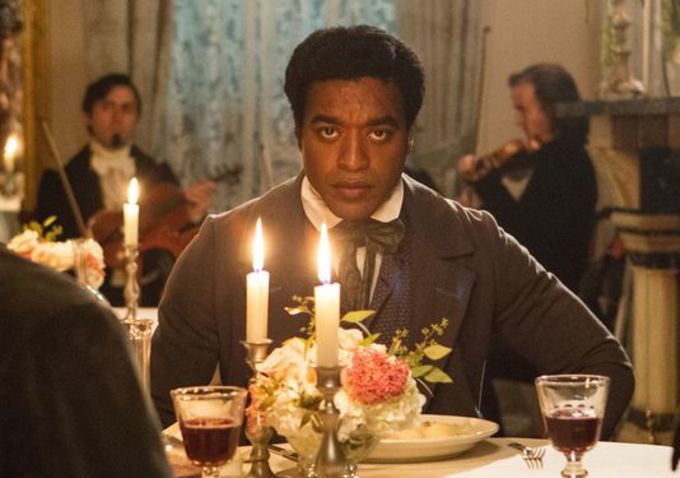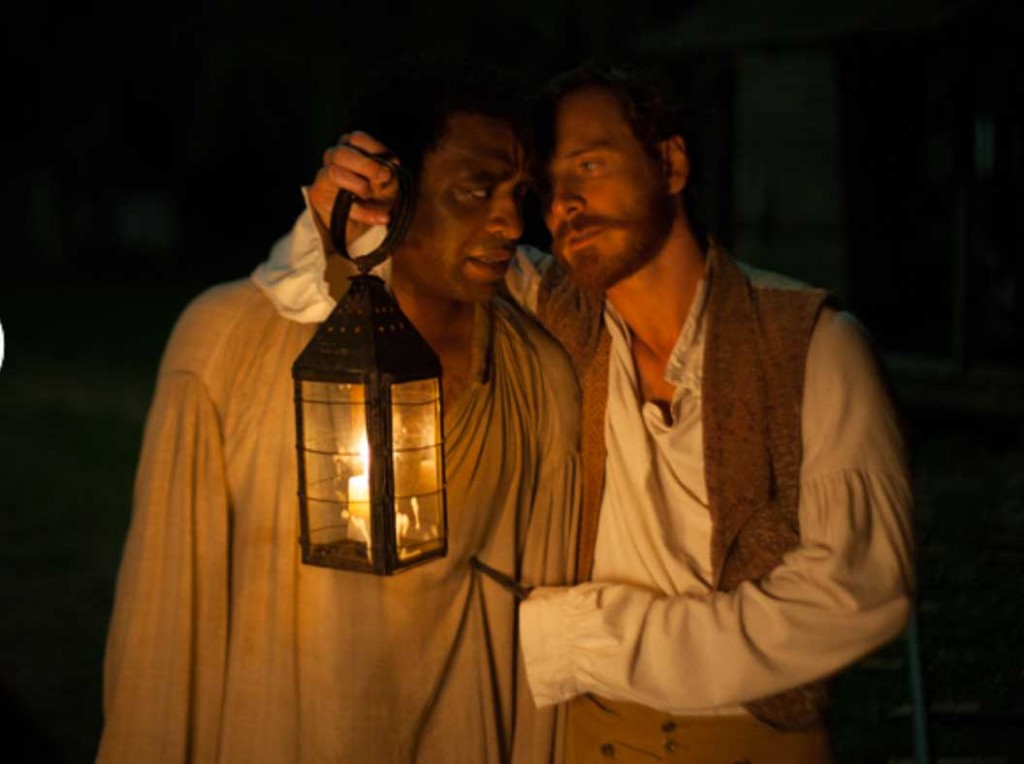NYFF51: The Myth of the Individual [Part 3]
 Steve McQueen’s 12 Years a Slave and J. C. Chandor’s All is Lost each strip their protagonists of all support systems, everything each thought was immutable in his life. They each articulate “King Lear moments” of overconfidence for men who have never previously grasped the importance of the context. What are the resources of the individual in an entirely inhospitable setting? For both a 19th century black American and a 21st century white American, a radical rupture in where he is clarifies who he is. Although both McQueen and Chandor have identified other motivations behind their films, in both there are also powerful dark truths about human connection, and a sense that alone we are almost meaningless fragments.
Steve McQueen’s 12 Years a Slave and J. C. Chandor’s All is Lost each strip their protagonists of all support systems, everything each thought was immutable in his life. They each articulate “King Lear moments” of overconfidence for men who have never previously grasped the importance of the context. What are the resources of the individual in an entirely inhospitable setting? For both a 19th century black American and a 21st century white American, a radical rupture in where he is clarifies who he is. Although both McQueen and Chandor have identified other motivations behind their films, in both there are also powerful dark truths about human connection, and a sense that alone we are almost meaningless fragments.
 12 Years a Slave is a groundbreaking cinematic adaptation of an 1853 slave narrative written by Solomon Northrup, and memorably acted by Chiwetel Ejiofor, a British born actor of Nigerian ancestry. It is the first slave narrative to be filmed. It is also the first film about slavery in America to be written and directed by artists of African heritage—McQueen is British-born and of Jamaica ancestry and writer John Ridley is an African-American born in Wisconsin. It is not the first to expose the savage treatment inflicted on slaves imprisoned by the plantation system, but it may be the first to convey it from the point of view of the slaves rather than that of a sympathetic Caucasian observer. It appears at a felicitous moment, when it is most needed to remind us all what it means for the wealth of the highest social class to be derived from the oppression of another segment of the population.
12 Years a Slave is a groundbreaking cinematic adaptation of an 1853 slave narrative written by Solomon Northrup, and memorably acted by Chiwetel Ejiofor, a British born actor of Nigerian ancestry. It is the first slave narrative to be filmed. It is also the first film about slavery in America to be written and directed by artists of African heritage—McQueen is British-born and of Jamaica ancestry and writer John Ridley is an African-American born in Wisconsin. It is not the first to expose the savage treatment inflicted on slaves imprisoned by the plantation system, but it may be the first to convey it from the point of view of the slaves rather than that of a sympathetic Caucasian observer. It appears at a felicitous moment, when it is most needed to remind us all what it means for the wealth of the highest social class to be derived from the oppression of another segment of the population.
At the outset, Northrup is a free man, a citizen accepted and valued. Despite the indisputable fact of the plight of other African-Americans in his time, his confidence in his own security as an American makes him trusting enough to believe that a pair of men who line their pockets by drugging free black men for southern slave markets are genuine when they wine and dine him under the guise of offering him professional advancement. McQueen likens him to Pinocchio being seduced by the promise of a life of glamour by the evil slavers in that story. Make no mistake, 12 Years a Slave is about a remarkable man, his ordeal (adapted from Northrup’s memoir), and the courage and intelligence he summoned in order to survive the vicious institutions of a racist nation. But collaterally, it also reflects the blindness of individuals to the big picture.
 Black and white, northern and southern, all people are but pieces of the larger pattern of the toxic slave “industry,” which rules them despite their individual intentions and situations. The scarred bodies of the black slaves and their enforced separation from their loved ones display most blatantly the tenor of the times. But slavery also takes a toll on its purported beneficiaries. The best, “Master” Ford (Benedict Cumberbatch), lives caught between his sympathies for a persecuted people and his terror that acting on such feelings might threaten his own position as a plantation owner. The worst, “Master” Epps (Michael Fassbender), wallows in the culture of domination at the price of his being as a man, only able to express sexuality and brotherly camaraderie with his slaves. The northern abolitionists hold their breath as they arrive to rescue Solomon, after an equally frightened itinerant Canadian carpenter, named Bass (Brad Pitt), alerts them to Solomon’s plight. The plantation system is a confirmation of the interdependence of all and the disaster for everyone of a legal mandate to tyrannize a specific subgroup.
Black and white, northern and southern, all people are but pieces of the larger pattern of the toxic slave “industry,” which rules them despite their individual intentions and situations. The scarred bodies of the black slaves and their enforced separation from their loved ones display most blatantly the tenor of the times. But slavery also takes a toll on its purported beneficiaries. The best, “Master” Ford (Benedict Cumberbatch), lives caught between his sympathies for a persecuted people and his terror that acting on such feelings might threaten his own position as a plantation owner. The worst, “Master” Epps (Michael Fassbender), wallows in the culture of domination at the price of his being as a man, only able to express sexuality and brotherly camaraderie with his slaves. The northern abolitionists hold their breath as they arrive to rescue Solomon, after an equally frightened itinerant Canadian carpenter, named Bass (Brad Pitt), alerts them to Solomon’s plight. The plantation system is a confirmation of the interdependence of all and the disaster for everyone of a legal mandate to tyrannize a specific subgroup.
The Northeastern states, though clearly imperfect, shine in 12 Years a Slave as the Promised Land. But one of the many interesting mysteries of the film is that, because we spend roughly ninety percent of the time in plantation hell, “free” New York state also glitters like a dream floating atop a possibly more innate reality of pernicious greed. Solomon’s escape, leaving thousands still in bondage, feels like a cancer in remission that might recur unexpectedly. The most astonishing individual courage can never neutralize the acid of an unjust society, and that may be the most painful truth McQueen has to offer.
 In All is Lost, another individual wakens from a dream of self-determination. The film is an ocean-voyaging American “divina comedia,” and a rebuttal of The Old Man and the Sea, a book that further elaborates on Hemingway’s bedazzled admiration for macho grace under pressure. In this film, hell, purgatory, and heaven are one and the protagonist’s confrontation with the ocean is a lesson about the perils of macho worship of elite, white American privilege and can be seen as an intriguing and contrasting companion piece to 12 Years a Slave. The film features only one character, identified as “our man” (Robert Redford). Fit and intrepid, he has the time, money, and inclination to intentionally isolate himself, and sail the largely uncharted Indian Ocean alone. “Our man’s” idyllic leisure, however, soon becomes as oppressive to him as Northrup’s abduction and evokes a different pervasive cultural infection.
In All is Lost, another individual wakens from a dream of self-determination. The film is an ocean-voyaging American “divina comedia,” and a rebuttal of The Old Man and the Sea, a book that further elaborates on Hemingway’s bedazzled admiration for macho grace under pressure. In this film, hell, purgatory, and heaven are one and the protagonist’s confrontation with the ocean is a lesson about the perils of macho worship of elite, white American privilege and can be seen as an intriguing and contrasting companion piece to 12 Years a Slave. The film features only one character, identified as “our man” (Robert Redford). Fit and intrepid, he has the time, money, and inclination to intentionally isolate himself, and sail the largely uncharted Indian Ocean alone. “Our man’s” idyllic leisure, however, soon becomes as oppressive to him as Northrup’s abduction and evokes a different pervasive cultural infection.
The film begins like Dante’s epic with “our man” stating in voiceover that he has lost his way. It ends, like The Divine Comedy, with an image of salvation. In between, “our man” fights the ocean encroaching on his yacht, damaged by the flotsam from the wreck of a commercial cargo ship. He is a paragon of individual fortitude, Thoreau’s ideal individualist, a John Wayne of determination. But unlike in the American literature of self-reliance, this is not enough. Once “our man” is cut off from others, hope rests only in the re-establishment of connection. McQueen’s vision of the tragic cultural invention of a black slave population is complemented by Chandor’s image of the grandiose cultural fantasy of a naturally heroic white elite. American hubris abounds.
In the fourth and final installment, we watch NYFF take on love, and perhaps shed some light at the end of the tunnel.
 This post is part of an ongoing partnership between the University of Wisconsin-Madison’s Antenna: Responses to Media & Culture and the Society for Cinema & Media Studies’ Cinema Journal.
This post is part of an ongoing partnership between the University of Wisconsin-Madison’s Antenna: Responses to Media & Culture and the Society for Cinema & Media Studies’ Cinema Journal.


